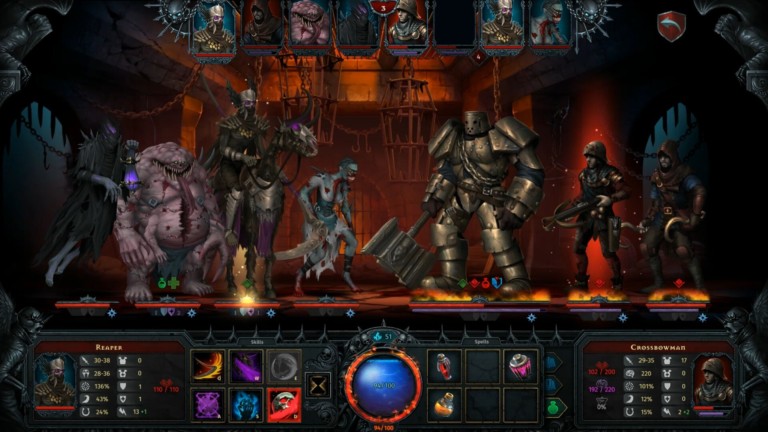Iratus: Lord of the Dead by Unfrozen
Iratus: Lord of the Dead is a tactical, turn-based RPG designed in the style of Darkest Dungeon.
Here, however, you’re taking on the role of the titular necromancer working his way up from the depths and amassing a vast army of zombies, skeletons and other undead horrors to fight his way to the surface world and unleash his apocalypse. Coupling a strategic aspect where forces are constructed, upgraded and organized with a tactical RPG combat system, Iratus packs a lot of content that is only bolstered by its DLC: Wrath of the Necromancer.
Old-Fashioned RPG Features Rise from the Grave
I can’t think of more appropriate praise for Iratus than to say that this feels like an old fashioned game, bristling with over-the-top thematic dialogue and featuring several layers of interconnected systems that all feed into a brilliant tactical experience that elegantly fuses RPG and tactics conventions.
A thorough tutorial manages to both teach all of these different aspects of the game while still remaining entertaining; no simple feat. My only criticism is that this tutorial is locked to easy mode and requires completion before the real game can start. Some may argue that this is sensible; the game is honest about its difficulty and even comes with a warning up front that this will be a challenge, but I would have liked the choice to begin my first playthrough on standard difficulty.

Once the tutorial was out of the way, I decided to start a new game on normal difficulty and get going. The majority of the game is split across two sections: one within the necromancer’s dark lair and the other in combat with enemies. The lair is used for a variety of purposes, but the most important is the construction of new minions.
Freak Out with Frankenstein Fantasies
A sizeable list of undead options unfolds as you progress through the depths. In a delightfully grim addition, these can be crafted from the remains of those you slay on your campaign with prize “bits” contributing stronger stats to the created undead. Brains harvested from slain enemies can even be infused into undead minions to give them an instant upgrade to a higher level.

Other options include an alchemy lab for creating potions for use in battle, an inventory of artifacts for use by both minions and the necromancer himself, a codex of discovered enemies, a talent tree for the necromancer and even a subterranean graveyard for long-term buildings that provide sizeable boons, such as XP for slotted minions.
The minions themselves remain the stars of the show. I was pleased to find that they could be given different skins, although the choice is a tad limited (it would have been nice to be able to customize the appearance of each part of a minion in a more precise way). I did love that I could rename my minions, giving them that little bit of personality which, of course, makes it all the more painful when they perish.

Skeletons Strategize
The other side of the game is battle, which is handled in a row-based system where four undead fiends line up against whatever is in their way and go to town. The various interactions between the different underlings are fantastic, and a variety of strategies become immediately apparent.
One of my favorite early game techniques was to combine the Dark Knight’s ability to deal damage based off of his defensive stats with the buffing capabilities of the basic Skeleton, upgrading a forward bulwark’s offensive and defensive strengths simultaneously, while placing an archer in the rear for some long-range firepower. This is just one of countless possible approaches.
The enemy variety is also impressive, and they have synergistic strategies of their own. Early foes range from miners to mad mages, but they soon start to get tougher as dwarves and other robust foes begin to show up. They’ll all eventually contribute to the undead horde, of course, but until then they pose a strong threat, and Iratus pulls no punches once the early stages of the game are out of the way.
One lovely little detail here is that these poor fools have sanity meters (in an amusing inversion of the themes of Darkest Dungeon), which can be depleted for cruel results.

Excellent Alluring Evil
The visuals here are excellent; the game drips with necromantic oozes and every minion is fantastic in its personality and unique flavor (ew).
The music manages to back this up with dark themes and ominous notes underscoring every self-satisfied monologue the eponymous necromancer decides to unleash. The presentation here is superb across the board.
All in all, Iratus is an excellent tactical RPG game that offers immense depth and an enormous challenge worthy of the most ambitious lord of carrion. If you’re looking for an engrossing RPG adventuring experience with lots of character and deep tactics, then you will find a lot to love here.
The boost in content offered by Wrath of the Necromancer ensures that Iratus will keep delivering shambling fun for a long time before it finally rots away.
Iratus: Lord of the Dead and the Wrath of the Necromancer DLC are available via Steam.
Check out the official trailer for Iratus: Wrath of the Necromancer below:





